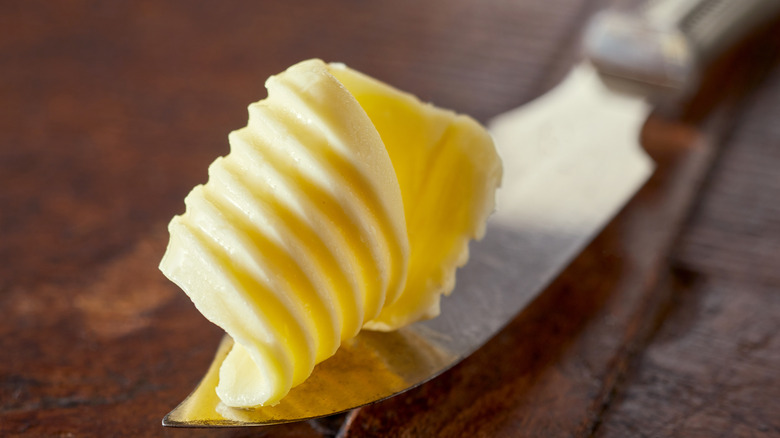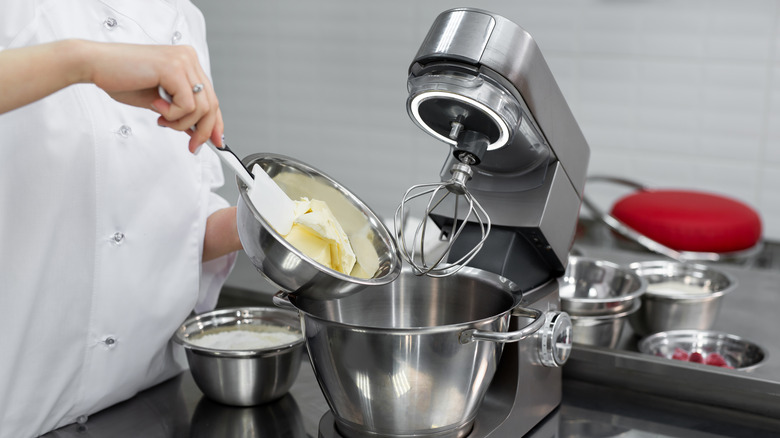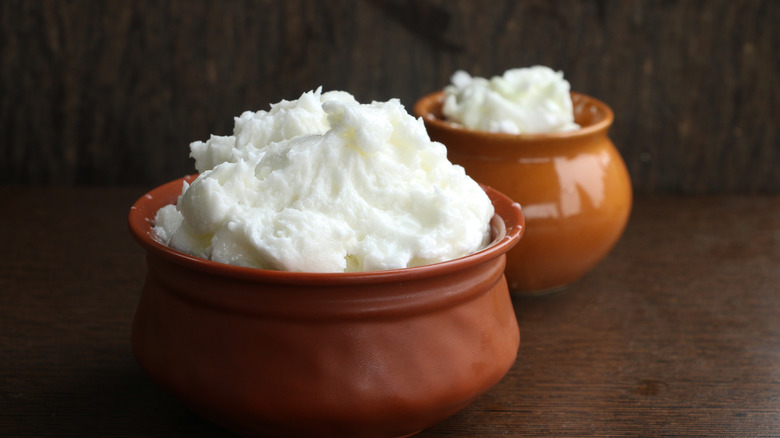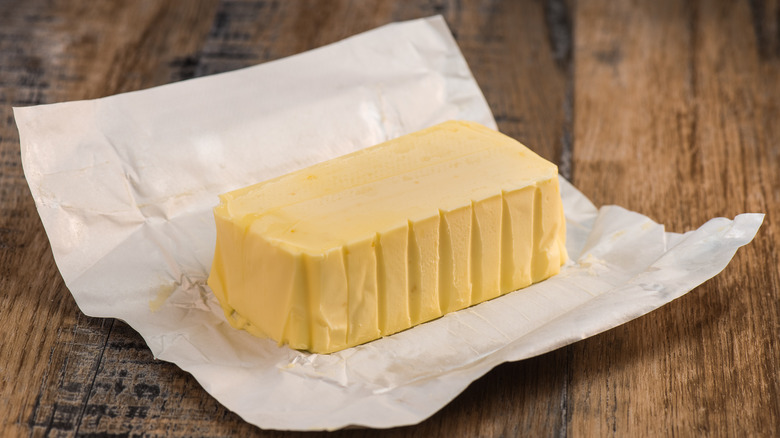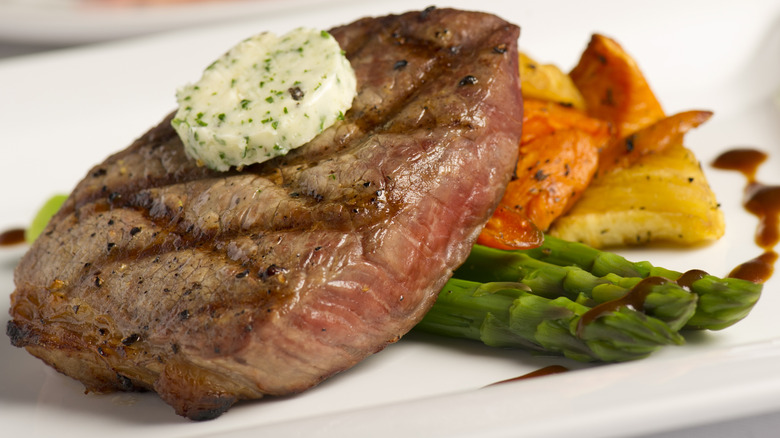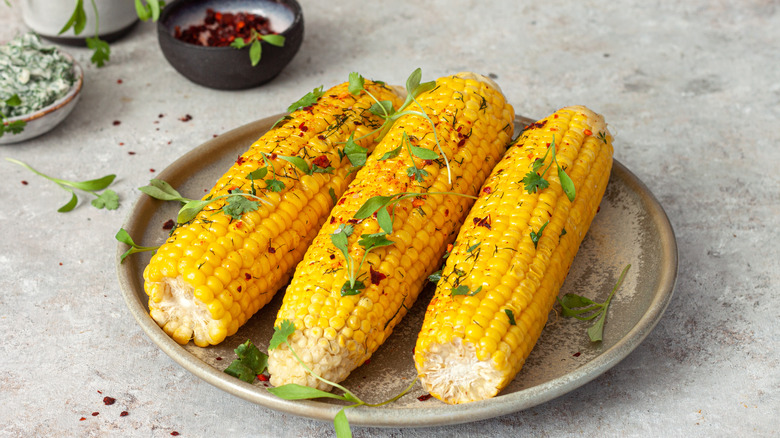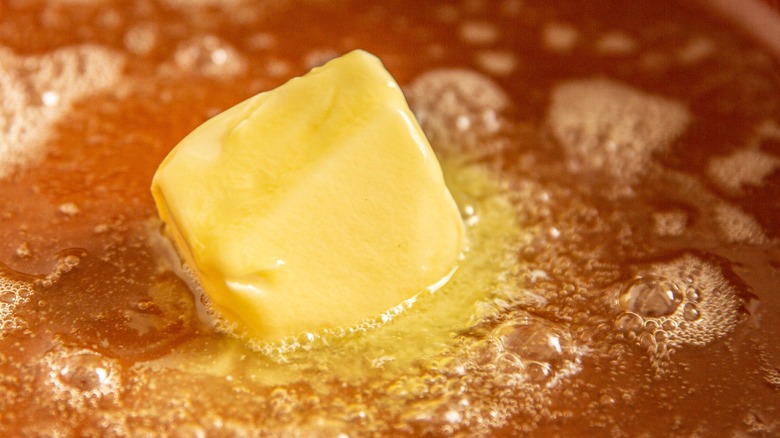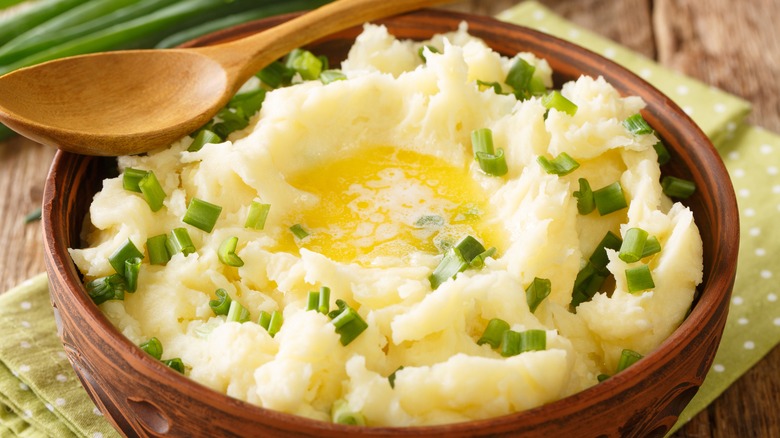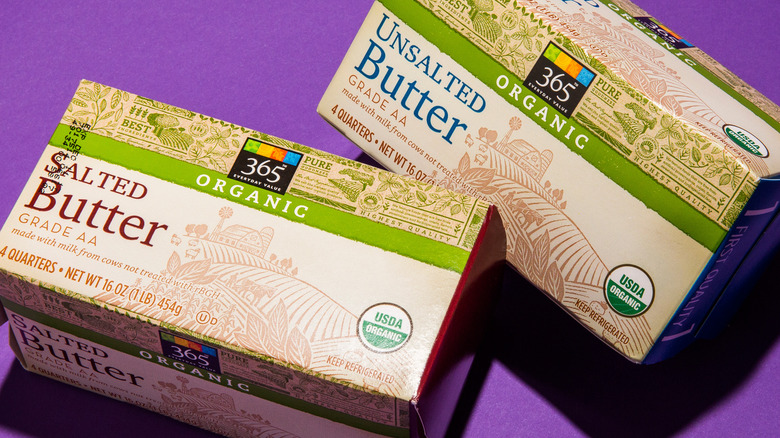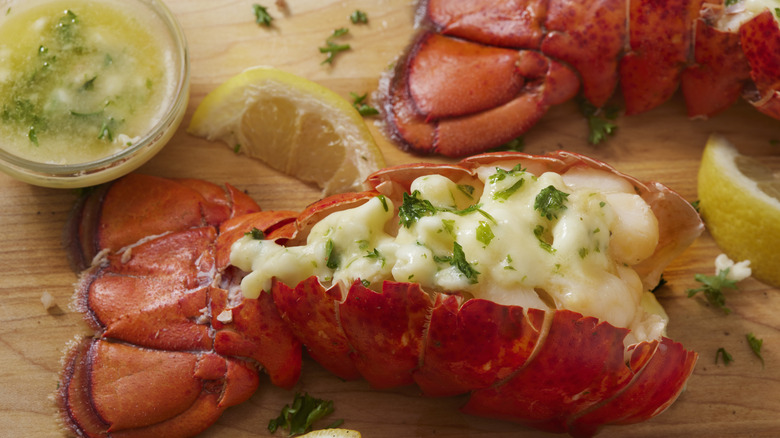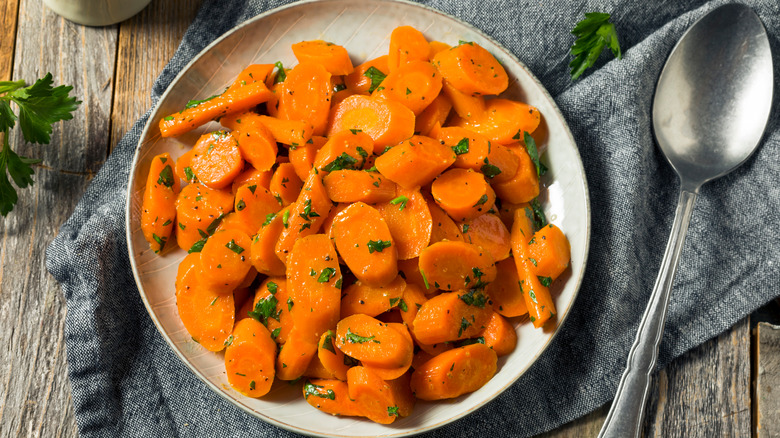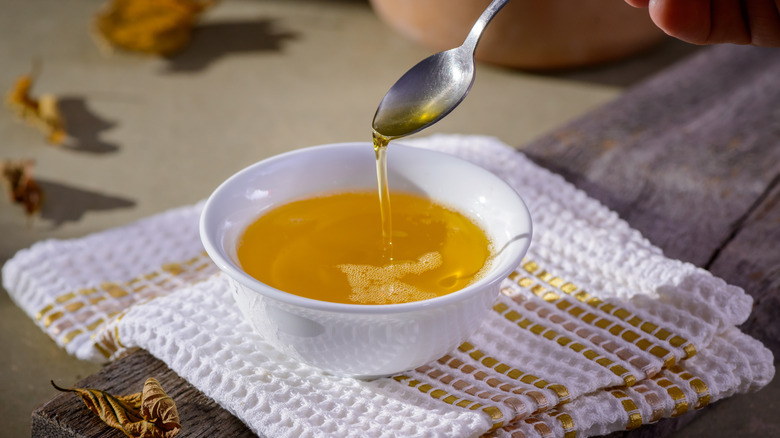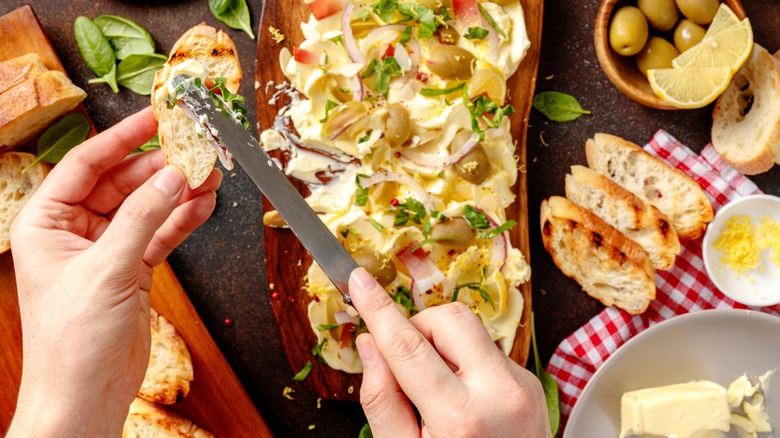Why Butter Always Tastes Better When Eating At A Restaurant
While it's wonderful to find a sensational salad spot for lunch, dining out can be extra special when it's indulgent. That means ordering dishes that you can't make yourself at home, or enjoying ones that are made by a professional chef. The sheer act of not cooking can sometimes make food taste better than it might if you've been putting the work in for hours prepping dishes in a hot kitchen. But if you're wondering why even butter always tastes better when eating at a restaurant, then you're about to find out. Surely, chefs are using the same type of butter in the same way as you would at home, right? Not quite.
Pro cooks are skilled in how to best work with butter. They know whether to melt it first or mix it with ingredients and chill it. They can serve it in liquid form and heat it up to turn it into a special sauce that's scrumptious with almost any type of food. The rich, creamy taste of butter gives any dish a decadent edge, while also evoking a home-comfort feel. Butter can be dressed up in a fancy restaurant, or served in the most casual way in a laid-back eatery. Next time you eat out, choose some dishes that are buttery because it's with these recipes that chefs can really shine. Once you know what restaurant cooks do with butter, you can bring these ideas home and try them out in your own kitchen.
Chefs use fresh butter at room temperature
How long does it take you to get through a pack of butter? Does it hang around in your fridge waiting to top baked potatoes, roasted corn, or toast? In a busy professional kitchen, ingredients are ordered all the time because there's a greater turnover. And butter certainly doesn't sit around half-used for a long time. Butter often tastes better when you're eating it at a restaurant simply because it's super fresh.
Another important factor is that a lot of chefs like to keep fresh butter at room temperature rather than in the refrigerator. They might do this so that it's soft enough to add to a mixer when baking. Butter that's stored out of the fridge tastes better, too. It's creamier, and the buttery taste is richer. Diners notice the taste way more than they would if they were served cold, hard butter from the chiller that had been hanging around for a while.
Some restaurants serve little packets of butter rather than a pat. Because these are sealed, they tend to be a lot fresher, too. Chefs may use large packs of butter in the kitchen, and these are less likely to deteriorate as quickly as smaller ones bought for your home. If you're wondering how long butter can be kept at room temperature then it's good for up to 10 days. However, the quality will go down after a couple of days.
Butter is whipped for pancakes
When you order pancakes at a restaurant for breakfast or brunch, do you love a pat of butter on top? As it melts, it spreads out over the top of the stack, and drips down as it soaks into the doughy delights. As if this wasn't scrummy enough, chefs often use a simple technique that makes buttery pancakes even better: they whip the butter. Now you know why butter on a stack at home doesn't taste as good as it does at a restaurant. You still get the same taste, but whipped butter is basically lighter, and has a softer, more aerated consistency. This creates a wonderful taste sensation, and also helps the butter melt quickly into your pancakes. Other ingredients can be whipped into the butter, too. Part of the joy of eating out is in the presentation of dishes. And whipped butter looks so much fancier than a plain pat of butter that's had no chef-work done on it. What's impressive is how chefs put real effort into elevating dishes.
It has to be said though, that it might not be whipped butter that's making those doughy discs taste so good. Some chefs prefer buttery-tasting margarine which melts into the dish easily, too. In other words, butter might taste better at a restaurant because it's not butter! If you have a stand mixer and want to give this restaurant-style, whipped-butter method a try, then whipped honey butter is a great recipe.
Different types of butter are used
When you go to the grocery store do you buy a low-fat version of butter, or perhaps a family pack that spreads easily? Do you tend to be driven by price, opt for a specific brand, or do you push the boat out and only take home gourmet varieties made with organic ingredients? You don't need to be a butter expert to know that not all types of butter are created equal. And one of the reasons that butter always tastes so much better when eating at a restaurant is that chefs know this. Pro cooks may stock up on different kinds of butter for when they are making a sauce or dip or glazing some vegetables. They may have a type of butter they only use for baking and another one that they serve to diners with a roll before the appetizers, main meals, and sides are served. A lovely butter can reveal the quality of a restaurant.
European butter, for example, has a richer taste because it generally contains more butterfat than butter made in the U.S. Meanwhile, butter from certain countries tastes different, too. Irish butter is wonderfully creamy with a yellow hue. That's because of the lush pastures the cows graze on which affects the different nutrients in the dairy produce. There are other types of butter available, too, from grass-fed butter to salted butter with flakes of sea salt, and cultured butter made with live cultures.
Herby compound butter finishes off a dish perfectly
Ever dabbed a bit of butter on a juicy steak with some seasoning? It might taste good, but at a restaurant, the butter always tastes better. It looks more solid, and other ingredients are well incorporated. It takes longer to melt, and is round and neat looking. It just looks like it's been prepared by a proper chef. That's because it's not just butter from a tub or packet, but compound butter which is used for finishing dishes.
Herbs and spices are mixed in with softened, unsalted butter. It's then rolled into a sausage shape in some greaseproof paper, which is twisted at both ends to dispel any air. The tightly wrapped roll is chilled. Chefs then unwrap it, and cut herby-butter discs from the log to add on top of dishes just before serving. A great combination is a brown butter log with tarragon and pink grapefruit. A compound butter recipe you might want to check out is a simple garlic butter. You can add this to grilled meats, pasta, and baked potatoes, or add some to some greens or luxurious mashed potatoes. Meanwhile, a perfectly grilled flank steak with chopped parsley goes great with garlic mixed with unsalted butter. Lemon zest can be added for a citrus punch that brightens the herby taste.
Flavored butters are becoming fancier
Butter doesn't always get good press. There's often a focus on the fact that it's a dairy ingredient and high in fat. There are a lot of butter alternatives out there, too, from low-fat spreads to plant-based ones. However, butter is not falling out of favor, but rather making a comeback. And what's definitely on-trend is butter that is flavored. Chefs who give butter some extra flavor know that this is why their fancy restaurant blends always taste better.
An example that has been spotted on menus is Japanese togarashi lemon butter, which adds some heat and citrus flavor. Seaweed butter might not sound immediately appealing, but kombu butter adds an umami boost. Other chef-inspired flavored butters include ingredients such as sambal, black truffle, and pepperoni. And don't even get started on how good butter flavored with bourbon, molasses, maple, and cloves sounds. Flavored butter can be sweet, too, and it doesn't have to be complex if the ingredients pair well and are at a gourmet level. Add a sprinkle of pink Himalayan salt with some chives, and you have a simple yet powerful salty, peppery butter taste. There really is no end of interesting combinations you can find from miso and poppy seed, to chili and lime, and even bacon and cheese.
Chefs know how to make brown butter
Restaurant chefs know how to make butter lip-smackingly moreish because they've got a few techniques that they regularly use. If you can't get enough of the flavor of melted butter that tastes like liquid creamy goodness, then you're bound to adore brown butter. Chefs use the right type of pan at the right temperature, so that the butter melts, foams, and changes color and taste. They move the pan at the right time to control the heat and the bubbles. As soon as it's done, the brown butter needs to be taken off the heat, and poured into a dish that's not hot. It takes practice to make sure the temperature of the butter doesn't go over 180 degrees Fahrenheit. Chefs whisk the butter as it heats up to keep it from getting too hot.
A great introduction to this technique is to try an easy brown butter sage sauce recipe. You need to brown it first until it releases its unique nutty aroma, and then add in fresh herbs. It takes some focus to not burn the butter. If you do, you'll have to start over. Brown butter is used by pastry chefs to make sweet French pastries, and it's great poured over some delicious al dente pasta.
There is often a lot more butter added to mash
Mashed potatoes always taste better at a restaurant for a variety of reasons. The leading one is that chefs don't scrimp on the butter. They know that melted butter makes mash smooth, velvety, and creamy. Butter can even add a little sweetness to vegetables when it melts, which goes down well when dining out and indulging. Who doesn't love to see a pat of butter slowly melt into a side of mashed potatoes? Famous French restaurateur Joël Robuchon's mashed potatoes had a quarter to even half the potatoes' weight of butter mixed in. One of his recipes uses less butter, with four times more potatoes. There's no mistaking that butter isn't just an add-on ingredient, but integral to making mash. As a general guideline, you might want to think about adding a couple of ounces of butter per large potato.
Some chefs like to heat the butter along with cream before adding to the potatoes. Chefs might favor using European butter as it's higher in fat, and this results in a more buttery taste. Mash tastes better if butter is added to dry potatoes, so chefs who prep dishes well in advance might leave cooked potatoes out to lose some moisture before buttering them up. Home cooks can up their game by trying out different mashed potato recipes, if they would like. Just make sure you've got a lot of butter ready to whisk into your potatoes.
Chefs cook with unsalted and salted butter
While chefs may be considered culinary creatives, there's a lot of science in cooking. And this applies to cooking with butter, too. Pro cooks who can successfully make a whole menu of dishes, tend to know when to use salted butter, and when to opt for unsalted. The regular butter you use every day, to spread on your bread, is probably salted. However, it'll be rare to find a restaurant kitchen that doesn't also stock unsalted butter. No good chef worth his or her salt — no pun intended — would not turn to unsalted butter for its creamy, more neutral taste. Knowing when to use this is the key to why butter always tastes better when eating at a restaurant.
When professional chefs bake, they want the right balance of ingredients to make cakes and cookies without salt getting in the way. This is certainly true when butter is added to a dish that contains delicately flavored ingredients. Salt is a fabulous flavor enhancer, but it's not supposed to be the overriding taste. Chefs do cook with salted butter, too, but only for certain dishes. The salt boosts the savory taste of scrambled eggs, and can lift every element of a stir-fried veggie dish.
Creative butter sauces are served
Quality chefs know how to whip up a traditional butter sauce. Kitchen pros know that classic bearnaise sauce needs tarragon, and that beurre blanc is made with white wine, vinegar, and shallots. A good chef should be able to rustle up a hollandaise sauce made with egg yolks. It's these creamy, rich sauces that transform succulent steaks and fresh seafood, and create well-known dishes such as eggs Benedict. Butter tastes better when it's eaten at a restaurant because it's turned into a sauce that smothers a main course, promising a buttery bite with every forkful.
And chefs are getting more creative with their butter sauces, too. Imagine how good pan-seared shrimp tastes with a serving of spicy barbecue butter sauce. How mouthwatering does a lobster beurre blanc sound served with lobster? And if you're a seafood lover, then you could be bowled over by striped bass served with a key lime butter sauce. Chefs can pair ingredients and flavors to elevate dishes. And part of their culinary skill might involve coming up with imaginative butter sauces that tempt the taste buds, and perhaps matching these with some flavored butter to create a whole flavor profile for a dish. Following culinary themes, whether French-inspired or coming out of the South, butter sauces are the perfect creamy base to add herbs, spices, alcohol, and more.
It is used to glaze vegetables
Ever noticed how veggies always taste better at a restaurant? One of the reasons is that chefs know just how to butter up side dishes of vegetables. They want you to dig into bowls of carrots and green beans like you're scooping some candy onto your plate. The butter adds a lovely sweetness to veg, and it also adds a shiny veneer that makes the fresh colors really pop. Compare a plate of unbuttered veg with a glossy buttered one, and it's clear which one looks the most appetizing.
Chefs don't just add a pat of butter on top either. They use butter to create a glaze, often adding other ingredients. A classic glaze that's used for carrots, for example, is butter combined with honey. The classic way to glaze is to drain off all but a couple of tablespoons of the water used for boiling vegetables. Add some butter to the liquid and let it melt, coating the vegetables, and making sure every bite has a rich, buttery taste. All that's needed then is a final flourish of seasoning.
Diners enjoy butter dips in restaurants
Restaurant chefs are great at taking an ingredient many people love and making it even more delicious. Instead of offering butter with bread rolls before a meal, or using it to glaze veggies or cook with, a favorite way to serve it is as a dip. Who doesn't like the idea of dipping anything into a pot of buttery goo? That's a hell to the yes alright, especially when it's served with crab legs. But how do they do that?
In some restaurants that little pot of molten, buttery gold is literally just melted butter. It's called drawn butter and sometimes has other ingredients added such as garlic or herbs. It's super simple, and a good example is our copycat Papa John's garlic sauce recipe. Add salt, onion powder, and garlic powder to melted unsalted butter, and you have a dip that's perfect for serving with pizza. However, if you're eating at a fancy restaurant, then you'll probably be served clarified butter. This is essentially butterfat and tastes so good. Chefs melt butter slowly so that the water burns off. They then strain the melted butter so that the milk solids that form are removed. A fine mesh strainer or cheesecloth can separate the ingredients. In Indian restaurants, ghee, which is a type of clarified butter, is often made.
Butter is served as the star ingredient
If you love the creamy taste of butter, then you probably can't wait to spread a generous amount on a pre-dinner roll. Biting into the soft, buttery texture on a warm, doughy roll really gets your appetite going. One of the reasons that butter always tastes better when eating at a restaurant (at least at some sharing-style cafes and bistros), is that it's given a more starring role on the dinner table. At Quality Bistro in Manhattan, butter is served as a centerpiece to be spread on a marble platter, with delicious ingredients like Filone bread and cornichons to dip in. These boards can look like colorful depictions of culinary art, with butter being the all-important backdrop.
This is an upmarket version of a butter board. This concept was pushed into foodie fashion via TikTok, and the beautifully designed butter board is definitely an Insta-worthy dish that's made for casual grazing with friends at a hip eatery. It's basically butter pats spread onto a board that's dotted with other delicious ingredients such as fruit and vegetables. Diners simply grab a piece of bread or a crudité, and drag it across the butter so that it scoops up some of the creamy deliciousness. There are plenty of tips for making the perfect butter board at home if you can't wait until you eat out.
